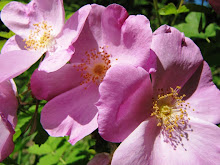
Black-capped Chickadee
On a walk about the fields with my camera, I came across (above photo) this old bluebird house. I was surprised to see a Black-capped Chickadee looking into the house as though he was about to claim it as his own. I guess he thought it looked like a good spot for a chickadee nest!
The Black-capped Chickadee is very common in the northern United States. It lives in both deciduous (dee-sid-yoo-us) and coniferous (con-if-er-us) forests. Deciduous trees are those which lose their leaves in fall, like oak or maple trees; coniferous trees are those which keep their leaves (needles) year round, like pine or spruce trees. Black-capped Chickadees nest in holes they make themselves in the rotten wood of a dead tree or in any handy hole they may find that is already made. They eat insects and seeds and are attracted to birdfeeders. The songs of the Black-capped Chickadee sound like "phee-phee" or "chick-a-dee-dee-dee." To go to a site where you can hear the songs of this cute, friendly little bird click here.
Below is a picture of a female American Redstart. This female bird can be a challenge to identify because it looks so different than the male with his black head, chest, and back, brightened by his blaze-orange shoulders and wing and tail patches. American Redstarts are common in much of the United States. They live in the brushy understory of deciduous woods where they dart about catching flies, mosquitoes (mow-skee-tows), and other insects. To go to a site where you may see a picture of the male and hear the call of the American Redstart, click here.

Another very common bird to see and identify is the American Goldfinch (photo below). You may see this bird just about anywhere in the United States. It loves weedy fields and lawns where it can find seeded-out dandelions and thistles, which are some of its favorite foods. It also likes to eat sunflower seeds and the seeds from trees. The song of the American Goldfinch sounds like "per-chik-o-ree" and may be heard by clicking here.
 American Goldfinch
American Goldfinch
 The Eastern Bluebird prefers to live in more open areas such as farmland, open woods, swamps and gardens where it feeds on insects of many kinds. The call of the Eastern Bluebird is a pretty whistling which you can hear by clicking here.
The Eastern Bluebird prefers to live in more open areas such as farmland, open woods, swamps and gardens where it feeds on insects of many kinds. The call of the Eastern Bluebird is a pretty whistling which you can hear by clicking here.
male Bobolink
In the picture above is one of my favorite grassland birds, the Bobolink. The male Bobolink has a yellow patch of feathers on the back of his head that looks like a dandelion in bloom when the bird is sitting on a grass stem! Bobolinks live in grasslands and hayfields and eat insects. They have a very cheerful and distinctive call which can be heard here.
White-throated Sparrow
There are many different kinds of native sparrows (native means that they were not brought to this country, but always lived here) all with their own special songs and habits. They are pretty and useful little birds and are fun to identify. In the picture above is a White-throated Sparrow, a very common bird in areas with dense brush. This bird is a seed eater and has a call that sounds like "oh-sam-peabody-pea." To hear the call of the White-throated Sparrow click here.
These are just a few of the hundreds of songbirds just waiting to be discovered by you while on an outdoor adventure. Learning to know our native songbirds is fun and makes being outside a treat for the eyes and ears every time you get out. The next time you are looking for fun outdoors, grab a bird book and a pair of binoculars and enter the world of songbirds!



No comments:
Post a Comment